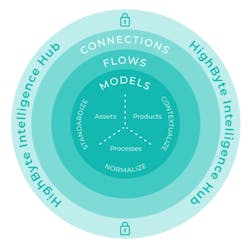New Software Readies Industrial Data for Analysis
A few months ago, we covered an emerging category of industrial software coming onto the market. This software, known as DataOps software, is designed to contextualize and standardize industrial data at the edge and manage its flow to various consuming applications.
Given the growing importance of machine and device data to modern manufacturing practices, the ability to contextualize and standardize data is a critical factor for Industrial Internet of Things or Industry 4.0 applications. To better understand the role of DataOps software, think of it this way: If you send a sensor’s data point feed with the name F8:4 and a value of 52.2 into an analytics software package, how does the analytics software know if this is a temperature value, or if it’s in Celsius or Fahrenheit, or where it comes from, or what operating limits it correlates to (i.e., is 52.2 an acceptable reading or an indication of a problem?).
In the article linked to above, we shared information about DataOps software from a new company called HighByte. Their software—HighByte Intelligence Hub—is now available.
To better understand how DataOps software would be applied across industry, HighByte launched a beta program in September 2019 involving nearly 40 manufacturers, distributors, and system integrators in 15 countries. Harrington noted that, through this beta program, five common application goals became apparent:
- Improving data preparation for analytics solutions. “Manufacturers typically have many off-the-shelf machines from multiple vendors,” he said. “While they can use existing solutions, like OPC servers, to standardize the communication protocol, some manufacturers were struggling with the fact that no standard semantics layer existed. Therefore, there was no easy and consistent way to standardize, normalize, and contextualize the data coming from all of these disparate machines—which had slowed their ability to use trending and analytics. HighByte Intelligence Hub helped them resolve this issue without having to write a lot of time-consuming scripts to massage the data and prepare it for analysis.”
- Achieving a multi-plant view. Harrington noted that one of the companies HighByte was working with in the beta program (a discrete manufacturer headquartered in the U.S. with global facilities) wanted to consolidate key information from the control system at each plant. However, each plant was using different applications and these plant systems were not set up consistently. “The manufacturer used HighByte Intelligence Hub to apply a standard set of data models within the plant,” he said. “The goal was to create a standard set of data models across plants by using HighByte Intelligence Hub to create an abstraction layer for plant-to-plant comparisons without having to rip and replace all of the existing diverse hardware and software at each plant.”
- Streamlining new system integration. “One company was trying to onboard multiple visualization and analytics solutions,” said Harrington. “They needed to standardize the data model sent to each application, rather than redundantly modeling data in each application. They used HighByte Intelligence Hub to securely connect these systems to the plant floor and then efficiently manage the flow of data when the needs of the system or the plant changed. The latter being really common.”
- Reducing cloud storage costs. To save on cloud storage costs and ensure the data they were sending to the cloud was actually useful, another beta program user applied HighByte Intelligence Hub to standardize data, add context to it, and then strategically reduce the frequency at which they were sending data to the cloud. “We are working with them now to quantify this cloud savings,” Harrington added.
- Building smarter machines. A machine builder participant in the program used the software as “an abstraction later that would allow them to leave their PLC logic intact while sending data to customer systems in a format the customer’s system wanted to receive it,” he said.
Penrod-Cambra added that the Intelligence Hub software is deployed on-premise and is available via an annual subscription. “The subscription includes upgrades throughout the year and unlimited support. There are no data tag limits and no connection limits. Rather, it’s simply priced per site; that is, one license required per facility, renewed annually,” she explained.
About the Author
David Greenfield, editor in chief
Editor in Chief

Leaders relevant to this article:


